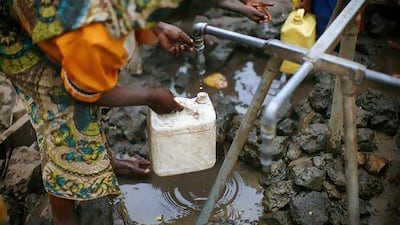Demand for fresh water and food is growing but good farming soil could run short in 50 to 70 years. Nanotechnology and the internet are tackling the problem. Tony Glover writes
Twenty-first century technologies are now starting to be used to satisfy the growing global demand for food and water.
The average person consumes about 30 kilograms of soil and two tonnes of fresh water a day, with some scientists now predicting that the world could run short of good farming soil within 50 to 70 years.
Not only are complex new sciences such as nanotechnology, engineering on a molecular level, now being applied to the problem but also new social networking technologies such as crowd funding.
"Certainly technology can and is helping a great deal to provide food for those that most need it," says Rob Enderle, the principal analyst at the Enderle Group in the United States.
Technology already patented in Europe involves a nanotechnology sieve allowing the filtering of small particles or biomolecules and organisms, such as viruses, out of water. Besides its application in water filtration, the nano sieve shows great potential as a solar absorber. The technology has been developed and patented by scientists from the Institute of Material Science at Kiel University and the Institute of Polymer Research at Helmholtz-Zentrum Geesthacht in Germany.
New technology start-ups in the US are now starting to shift attention away from consumer devices towards sciences such as nanotechnology. Puralytics, for example, produces products that use sunlight or LED light to break down and destroy contaminants in water for human consumption. Its SolarBag product, for instance, uses sunlight to detoxify water and make it safe to drink.
Puralytics is, however, a new company which began as a problem-solving exercise between its founder Mark Owen and two other inventors. The problem was how to find a business opportunity in the air or water purification space that would "have a high impact on the world".
But not all new water purification technologies rely on purely 21st-century technologies. Omani scientists at the Sultan Qaboos University claim that wasted date palm leaves treated with sulphuric acid at high temperatures can purify highly polluted water so effectively that it can be thereafter used to irrigate crops. A pilot plant is scheduled to be inaugurated in Oman next year.
However, although its creators hope that this simple process could be adopted across the Middle East, there are fears that a lack of funding for commercially unproven technologies in the region could hinder its widespread adoption. The lack of available funding to apply the latest technology to those areas of the globe most in need of irrigation and clean water is a common problem throughout the world.
This is one reason why biologically and genetically engineered food has been seen as the most practical solution to feeding people in the developing world.
"The reality is that the environment is very hard on technology solutions and, often when implemented, the equipment can't be protected," says Mr Enderle. "The best solutions remain engineered foods which the indigenous population can plant, harvest and consume because this not only feeds them, it helps make them self-sufficient."
But with increasing concern now emerging about the long-term health dangers of genetically modified meat and biologically enhanced crops, the IT industry is now turning towards internet-based technologies to raise funding that goes directly to help people in the developing world.
A new non-profit organisation, charity: water, is already harnessing the power of social networking to try to help solve the problem. Using photos, GPS satellite co-ordinates and videos, the organisation is able to use the internet to show individual online investors the impact their money is having.
Charity: water made an online film called Water Changes Everything explaining the areas of life affected by the water crisis, such as health, education and economy. It has so far been viewed nearly 300,000 times and translated into nine languages.
The charity's fundraisers use social networking tools to inform potential contributors not only of the nature of the work needing to be done but on specific projects urgently needing help.
As the online charity started to grow, it sent hundreds of cameras and GPS devices to the field and trained local partners to use them to develop more comprehensive reports to send back to contributors.
This process of combining local need with the power of the internet to harness public attention across the world is known as "crowd funding".
But what the world's arid deserts and hungry populations need is a combination of funding of new sciences such as nanotechnology together combined with the full immediacy of the internet to solve a tragic problem.
The IT industry, which is now starting to wake up to the scale of the potential global market for new water and irrigation technologies, is hoping that the rapidly worsening global food and water crisis will soon leave the world's governments no alternative but to open their wallets.

